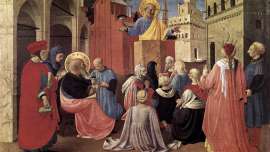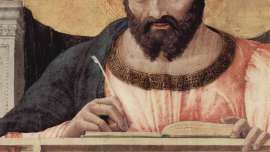Lesson Goals
- To understand the basic outline of Israel’s history in the centuries between the collapse of the Davidic kingdom and the beginning of the New Testament era.
- To appreciate how the collapse and disappearance of the Davidic Kingdom shaped Israel’s hopes and beliefs in the five centuries before Christ.
- To understand how God’s covenant promises were interpreted by Israel’s prophets and how those prophecies were understood in the last centuries before Christ.
Lesson Outline
I. The Kingdom That Did Not Come
A. Promise and Division
In our first lesson we looked at the origins of the Davidic covenant.
We saw how God’s promise to David, first delivered by an oracle of the prophet Nathan and later celebrated and meditated upon by the psalmists and prophets, marks the culmination of the salvation history told in the Old Testament.
The Davidic monarchy was the ultimate expression of Israel’s election as God’s chosen people. This election originated in the form of God’s covenant with the patriarch Abraham, father of the Israelite people. By this covenant God swore to make Abraham’s descendants a great nation, from whom kings would stem and through whom all nations would be blessed.
It was to fulfill His covenant promise to Abraham that God raised up Moses to lead Israel, the people born of Abraham’s seed, from captivity in Egypt. And it was to fulfill that covenant with Abraham that centuries later Israel’s King David was promised a divine dynasty – in which one of his heirs would reign over Israel for all time in a kingdom that would have dominion over all the nations and peoples of the world.
But historical events quickly overtook and called into question the meaning of God’s covenant with David. Within a generation after David’s death, the “everlasting kingdom” he was promised had vanished.
God’s promise seemed to have been clear – He would punish David’s sons should they prove unfaithful, but He would never withdraw His favor from David’s line (see 2 Samuel 7:5-15; 1 Kings 2:2-4: 8:25; 9:4-5; Psalm 132:12).
However, the abuses of David’s son, Solomon – who had been the immediate focus of Nathan’s promises – led to rebellion shortly after Solomon’s death in 930 B.C.
Ten of Israel’s twelve tribes, led by Jeroboam, split-off and established a Northern Kingdom, leaving Solomon’s son, Rehoboam, to reign over a Southern Kingdom consisting of the two tribes remaining in and around Jerusalem.
As depicted in Scripture, Jeroboam’s rebellion was God’s punishment for Solomon’s sin (see 1 Kings 11:31-39). The Northern tribes almost immediately went into apostasy, building altars and worshipping false gods (see 1 Kings 12:28-29). In 722 B.C., the Assyrians invaded the Northern Kingdom and hauled tens of thousands of Israelites into captivity. The Bible presents this as a punishment for their idolatry and sins against God’s covenant (see 2 Kings 17:7-18).
The Southern Kingdom, too, fell into corruption. In 586, King Nebuchadnezzar of Babylon crushed Jerusalem, destroyed the Temple and sent thousands off into exile (see 2 Kings 24-25; Jeremiah 52).
B. An Everlasting Throne Unseen
By the sixth century B.C., then, there was no Davidic Kingdom in sight.
This remained true even when Persia defeated Babylon in 538 B.C., paving the way for some Israelites to return to Jerusalem and begin rebuilding the Temple.
Throughout this “Second Temple” period and on into the last period recorded in the Old Testament – the period of the Maccabeean revolt and the Hasmonean dynasty circa 100-200 B.C. – we see little evidence that Israel hoped for any imminent return of the Davidic Kingdom.
The Maccabeean revolt was about covenant faithfulness – not the restoration of the Davidic Kingdom (see 1 Maccabees 1:15; 2:20, 49-68; 4:8-11).
Mattathias, one of the early heroes of the movement, affirmed his belief that “David, for his piety, received as a heritage a throne of everlasting royalty” (see 1 Maccabees 2:57).
But the revolt and the later Hasmonean dynasty did not invoke David.
The Hasmoneans were led by priests – not descendants of David. Yet the Israelites agreed to live under this form of priestly, theocratic rule “until a true prophet arises” (see 1 Maccabees 14:41). This was a reference to Moses’ ancient prophecy – that God would raise up a prophet like him (see Deuteronomy 18:15-19).
The Book of Sirach, written during this period, also affirms God’s promise to David, saying that God “exalted his strength forever….established his throne in Israel” (see Sirach 47:11). Sirach also affirmed that “God does not withdraw His mercy, nor permit even one of His promises to fail” (see Sirach 47:22).
Though we find no Davidic expectations in the latest Old Testament texts, such as Sirach and Maccabees, we know from the writings of the rabbis and others in the “intertestamental” period – the years between the writings of the Old and New Testaments – that there emerged a lively messianic hope based on God’s covenant with David and the promises of the prophets.
II. According to the Prophets
A. A New Exodus
In the eighth century, amid the confusion of a shattered monarchy, foreign invasion, and forced exile, Israel’s major and minor prophets first began to envision the restoration of the Davidic Kingdom.
Though these prophecies were delivered over the course of many centuries, their “format” is often very similar. In fact, often the prophecies seem deliberately patterned to evoke and recall Israel’s Exodus from Egypt.
In the “new Exodus” foretold by the prophets, God, out of compassion for His suffering people, will raise up a new David-like king to lead the people out of exile and restore them once again in the land under a reunified Northern and Southern Kingdom.
Hosea, writing from the Northern Kingdom in the 8th century B.C., said that the people would return to God under the banner of “David, their king” (see Hosea 3).
The people of “Israel” (the Northern Kingdom) shall be gathered together with the people of “Judah” (the Southern Kingdom). Whereas once they were called “Lo-ammi” (Hebrew for “no people”), when the Davidic King restores them they will be called “children of the living God,” Hosea promised.
This echoes God’s actions in the Exodus, where He called Israel his “first born son” and consecrated them as “My special possession, dearer to Me than all other people” (seeExodus 4:22; 19:5-6).
In Hosea’s prophecy we also hear an echo of the divine oath sworn to Abraham. Like the descendants of Abraham, the restored Kingdom of Israel will be more numerous than the sands of the sea (compare Hosea 3; Genesis 22:17).
Prophesying during this same period in the Southern Kingdom, Micah did not mention David by name, but spoke of a new ruler to be born in Bethlehem Ephrathah; this ruler would “shepherd” Israel and lead “the rest of his brethren” to “return to the children of Israel” (see Micah 5:1-4).
David, as all who heard Micah’s prophesy would know, was born in Bethlehem Ephrathah and was a “shepherd” (see Ruth 4:11,17; 1 Samuel 16:1,11). The promise of a reunion with the “children of Israel” is likewise the promise of a reunified kingdom.
B. From Zebulun and Naphtali
Amos, who ministered in Judah circa 750 B.C., also foresaw the “restoration” of God’s people and the raising up of “the fallen tent [kingdom] of David” (see Amos 9:11,14).
During the chaos of the eighth century, the prophet Isaiah likewise evoked the image of a new David.
He recalled the beginning of the end of the Davidic Kingdom in an obscure prophecy that, as we will see in our next lesson, becomes important in Matthew’s Gospel.
“First He degraded the land of Zebulun and the land of Naphtali, but in the end He has glorified the seaward road, the land west of the Jordan, the District of the Gentiles” (seeIsaiah 8:23; Matthew 4:15).
As the initial hearers of his prophecy would have known, that part of the kingdom where the tribes of Zebulun and Naphtali lived was first attacked by the Assyrians and the tribes were hauled off into captivity (see 2 Kings 15:29; 1 Chronicles 5:26).
This area, then, marked the beginning of the kingdom’s end. The final end of the kingdom, as we saw above, came in the sixth century B.C., when Jerusalem was seized by Babylon and the remaining tribes were driven into exile (see 2 Kings 24:14).
Isaiah prophesied that Zebulun and Naphtali, the lands first to fall into the darkness of degradation, would be the first to see the light of God’s salvation.
That salvation would come, he said, with the birth of an heir to David’s throne. The new king’s dominion would be vast and would endure “both now and forever,” Isaiah said (seeIsaiah 9:5-6).
Elsewhere, Isaiah prophesies the sprouting of a new shoot from the root of Jesse (seeIsaiah 11:1-16; see also Isaiah 55:3-5). Jesse, of course, was the father of David (see Ruth 4:11,17; 1 Samuel 16:1,11). Isaiah, then, is prophesying the coming of a new son of David.
As the Spirit rushed upon David when he was consecrated by Samuel (see 1 Samuel 16:13), “the Spirit of the Lord shall rest upon” this new shoot of Jesse (see Isaiah 11:2).
This new David will lead a new Exodus, Isaiah foretells – drying up the Sea of Egypt and making in its midst a “highway” for the scattered and exiled tribes to come back to Israel.
This new Exodus is envisioned as not only a restoration but a reunification of the Davidic Kingdom. The prophet speaks of a gathering of “the outcasts of Israel” from all the nations – “from the four corners of the earth.” In this new gathering of “the remnant of His people,” God will heal the rivalry between Ephraim (symbol of the Northern Kingdom) and Judah (symbol of the Southern Kingdom).
Jeremiah, who prophesied amid the corruption of Jerusalem in the early seventh century B.C., also spoke of God raising up “a righteous shoot to David.” His prophecy, too, alludes to a new Exodus that will restore and reunify the house of Israel (see Jeremiah 23:5-7;30:8-9; 33:15).
C. David in Exile
The prophet of the Exile, Ezekiel, also promised a new David.
Ezekiel sees this new David as a “shepherd” who would gather the scattered sheep of the flock of Israel
He, too, sees this David figure delivering Israel from bondage and exile and restore them to their homeland.
He sees too that this restoration to the land will announce a permanent reunification of the kingdom. “I will take the Israelites from among the nations to which they have come and gather them from all sides to bring them back to their land….Never again shall they be two nations, and never again shall they be divided into two kingdoms” (see Ezekiel 34:24-30;37:12,21-28; 16:59-63).
Ezekiel said that God would in those days make a new covenant with the people, an everlasting covenant of peace, and would dwell forever among them in the sanctuary. Isaiah, too, had looked forward to the day when God would “renew the everlasting covenant, the benefits assured to David” (see Isaiah 55:3-5; 42:6; Jeremiah 31:31-34).
III. Between the Testaments
A. Raising the Son of David
As with all of these prophesies, Isaiah here recalls the original Davidic promise and covenant (see 2 Samuel 7:11-16; 23:5; Psalm 89).
And these promises, mediated by the writings of the prophets and the psalmists, animate a number of the texts written during the “intertestamental period.”
For instance, the Psalms of Solomon, composed in the late first century B.C., express anger at the corruption of those who set up a “worldly monarchy” and “laid waste the throne of David in tumultuous arrogance” (see Psalms of Solomon, 17:5-9, 19-22).
The sins of this worldly monarchy are blamed for a foreign invasion of Jerusalem. Scholars believe that the psalmist is criticizing the rise of the Hasmoneans and blaming their corruption for the conquests of the Roman general Pompey in 63 B.C.
In light of these developments, the psalmist petitions the Lord to “raise up unto them their king, the son of David…that he may reign over Israel Thy servant.”
All the Davidic promises are present in the psalmists’ appeal – most prominently the expectation of Israel’s restoration and Israel’s dominion over all the world.
It is hoped that the new Davidic king will purge foreign invaders from Jerusalem and “gather together a holy people, whom he shall lead in righteousness….the tribes of the people that has been sanctified by the Lord his God…For all shall be holy and their king the anointed of the Lord” (see Psalms of Solomon, 17:21-37).
Here, and throughout this collection of psalms, we find echoes of and allusions to the Davidic promises (compare Psalms 2,18,104,101; Isaiah 42).
B. From the Caves of Qumran
Similar hopes for a Davidic Messiah are found in the Dead Sea Scrolls. The scrolls, too, reflect the views of Jewish believers opposed to both the Roman occupiers and the Hasmonean priests.
The scrolls use Davidic titles for the Messiah drawn from Scripture (for example, Isaiah 11:1-5; 2 Samuel 7:11-14; Jeremiah 23:5-6; 33:15-17; Ezekiel 34:23-24; 37:24-25).
They also reflect a faith in the promises of the Davidic covenant, notably the hope for a seed who reigns forever as an adopted son of God.
A fragment from Cave IV at Qumran (known as 4QFlorilegium or 4Q174) describes the awaited Messiah in these terms:
“The Lord declares to you that He will build you a House. I will raise up your seed after you. I will establish the throne of his kingdom forever. ‘I will be his father and and he shall be my son.’ He is the Branch of David who shall arise…in Zion at the end of time. As it is written, ‘I will raise up the tent of David that is fallen.’ That is to say, the fallen tent of David is he who shall arise to save Israel….”
As in the Psalms of Solomon, in this passage we have numerous quotations from the Davidic promise tradition (compare 2 Samuel 7:11-14; Amos 9:11).
We also have evidence of some Davidic expectation in the apocalyptic literature of the period – works like 4 Ezra, 2 Baruch and 1 Enoch, which date between the late second century B.C. to the first century A.D.
In these texts we find a composite picture of the Messiah – drawn from the royal Davidic promise tradition and the prophet Daniel’s visions of an everlasting kingship being given to “one like a son of man” (see Daniel 7:13-14).
These texts indicate that by Jesus’ time the Messiah was expected in terms that merged the Davidic promises and the prophecies of a quasi-divine son of man.
What we see then, in this overview of Jewish thinking in the years before Jesus, is that the contours and characteristics of the Davidic Kingdom promises were not abandoned.
It is true that between 500 B.C. and 100 B.C. there is not to be found a consistent or predominant strain of Davidic hope. But what we learn is that even without the witness of the New Testament, it would be possible to establish that among Jews of the first century A.D. there was a general expectation of a future restoration of the Kingdom of David by a messianic figure.
In our next lesson we will begin our study of how this Davidic hope plays out in the pages of the New Testament.
IV. Study Questions
- What nation conquered the Northern Kingdom of Israel and in what year?
- What nation conquered the Southern Kingdom of Israel and in what year?
- How did the prophets depict the restoration and reunification of the Davidic Kingdom as a “New Exodus”?
- Explain the meaning and significance of Isaiah’s prophecy concerning Zebulun and Naphtali (see Isaiah 8:23).


